1Password Chrome Extension not Working [SOLVED]
1Password Chrome extension might not work if its installation is corrupt. Moreover, the corrupt installation of the 1Password companion application or Chrome browser may also result in the error under discussion.
The issue arises when the user clicks on the 1Password extension icon (or tries to use the keyboard shortcut), but nothing happens, or only its settings menu is displayed. In some cases, the users were redirected to the 1Password website. For some of the users, the autofill feature does not work. The issue usually arises after an OS, Chrome, or 1Password application/extension update. The problem is reported on all the major desktop operating systems (Windows, Mac, Linux).
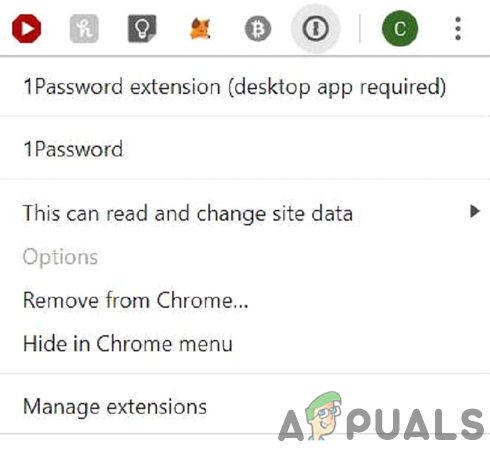
Before moving on with the solutions, relaunch the Chrome browser (after making sure no Chrome or 1Password-related process is running in the Task Manager of your system) to rule out any temporary glitch. Moreover, restart your system after completely exiting the 1Password application. Furthermore, make sure your license is valid (subscription or license-based). Also, make sure your antivirus/firewall applications are not interfering in the operation of the 1Password extension. Additionally, try to enable the Native Messaging Protocol in the Help<Advanced to check if it caused the issue.
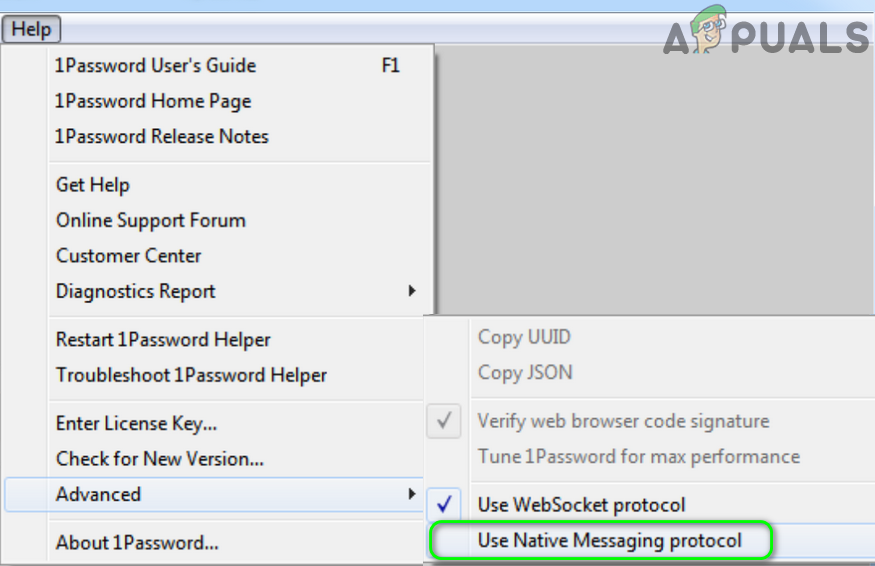
Solution 1: Update the 1Password Extension/Application to the Latest Build
The 1Password extension and application are updated regularly to add new features (mainly to make it compatible with the OS and browser) and patch the known bugs. You may encounter the error at hand if you are using an outdated version of the 1Password extension/application. In this case, updating the 1Password extension and application will solve the issue.
- Launch the Chrome browser and click on the Extensions icon.
- Then, in the menu, select Manage Extensions.

Open Manage Extensions in Chrome - Now, enable the Developer Mode and then click on the Update button to update the extensions.

Update Chrome Extensions - Then make sure the 1Password application is updated to the latest version (usually an automatic process).
- After updating the extension and application, check if the issue is resolved.
Solution 2: Update the Chrome Browser to the Latest Build
The Chrome browser is updated regularly to add new features and patch the known bugs. The 1Password extension may not work if you are using an outdated version of Chrome because it may lead to compatibility issues between the extension and Chrome. In this context, updating the Chrome browser to the latest build may solve the problem.
- Launch the Chrome browser and open its menu by clicking on the three vertical ellipses near the top right of the window.
- Now, in the menu, select Settings and then, in the left pane of the window, open About Chrome.

Open Chrome Settings - Then update the browser and click on the relaunch button (not just simply close and open the browser).
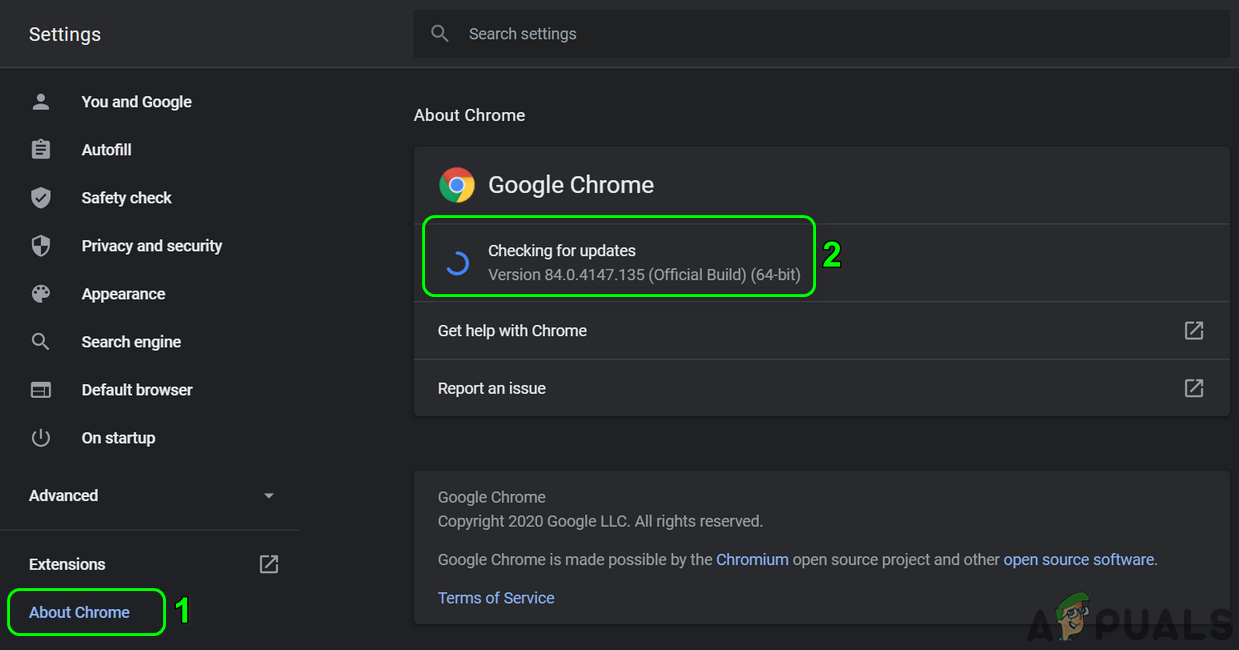
Update Chrome - Upon relaunch, check if the 1Password extension is clear of the error.
Solution 3: Use Only One Version of 1Password Applications / Extensions
Many people tend (although unintentionally) to install two versions of the 1Password extensions and applications, which may lead to the issue under discussion. In this scenario, disabling/uninstalling the other version of the extension or application may solve the problem.
- Launch the Chrome browser and click on the Extensions icon (near the right end of the address bar).
- Now, in the menu shown, select Manage Extensions.
- Then check if there are more than one 1Password extensions, e.g., 1Password extension (Desktop App is Required) and 1Password X. If so, then disable or remove one of them and then check if the issue is resolved.
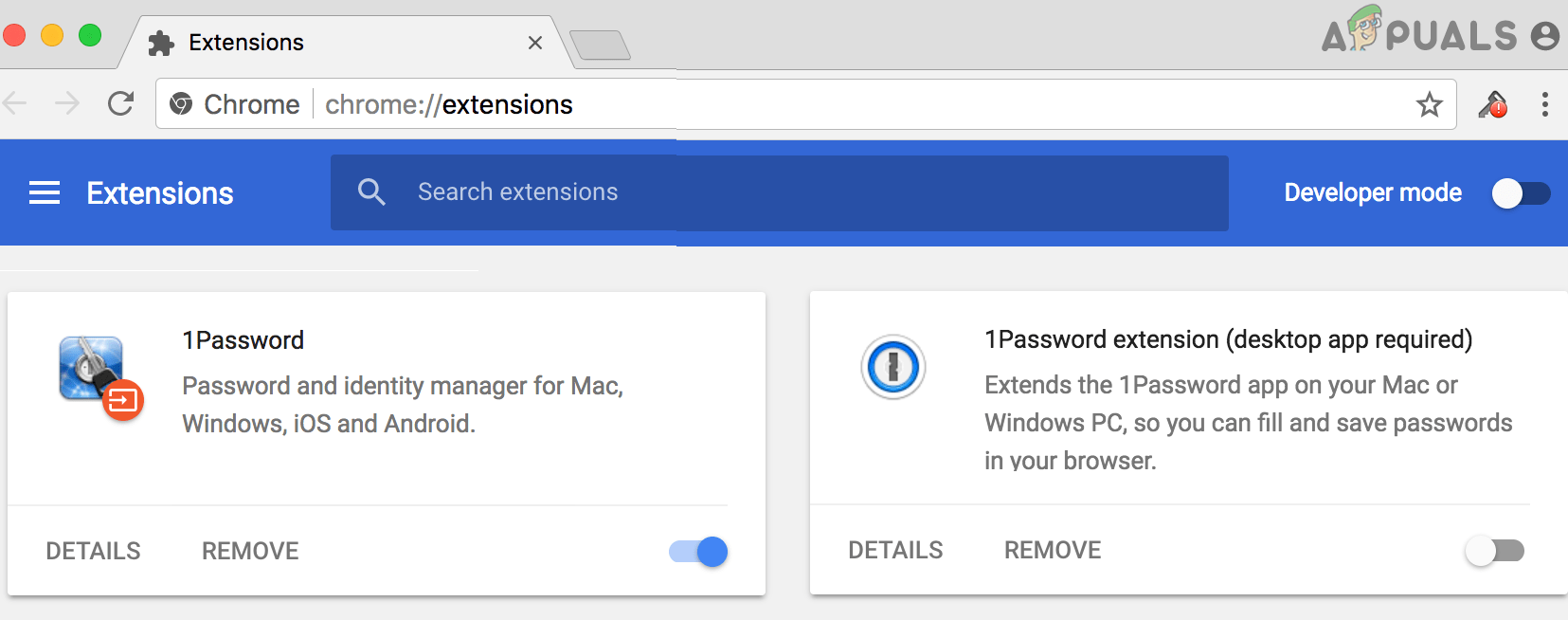
Disable One of the 1Password Extensions - Also, check your installed applications for more than one version of 1Password, e.g., one from the OS store (Mac or Windows Store) and other from the 1Password website. If so, then remove one of the versions and then check if the issue is resolved.
Solution 4: Reinstall the 1Password Extension
The 1Password extension may not work if its installation itself is corrupt mainly due to an interrupted installation. In this case, reinstalling the extension may solve the problem.
- Back up the information/data of the websites in the 1Password extension.
- Launch the Chrome browser and click on the Extension icon (the last icon in the extensions shortcuts).
- Now click on Manage Extensions and then click on the Remove button under the 1Password extension.
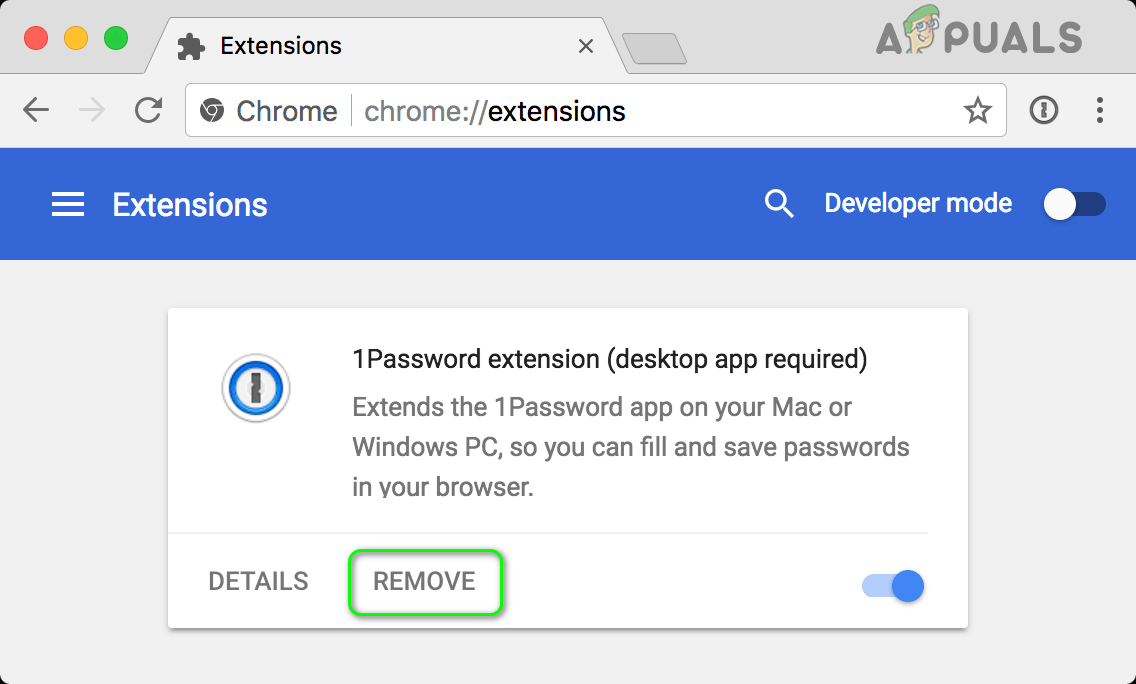
Remove the 1Password Extension - Now confirm to uninstall the extension and relaunch the Chrome browser.
- Upon relaunch, reinstall the 1Password extension and check if it is operating fine.
- If not, repeat steps 1 to 4 and then restart your system.
- Upon restart, launch the 1Password application and then launch Chrome.
- Now reinstall the 1Password extension and check if the issue is resolved.
Solution 5: Enable the 1Password Extension Helper
To function correctly, the 1Password extension requires the extension helper setting (in the system preferences) to be enabled. If the extension is disabled, 1Passowrd will not be able to sync properly. In this context, enabling the extension helper may solve the problem. For illustration, we will try to guide you on the process of a Mac system.
- Launch the Preferences of your Mac and then navigate to the Browsers tab.
- Now check the option of Always Keep 1Password Extension Helper Running.
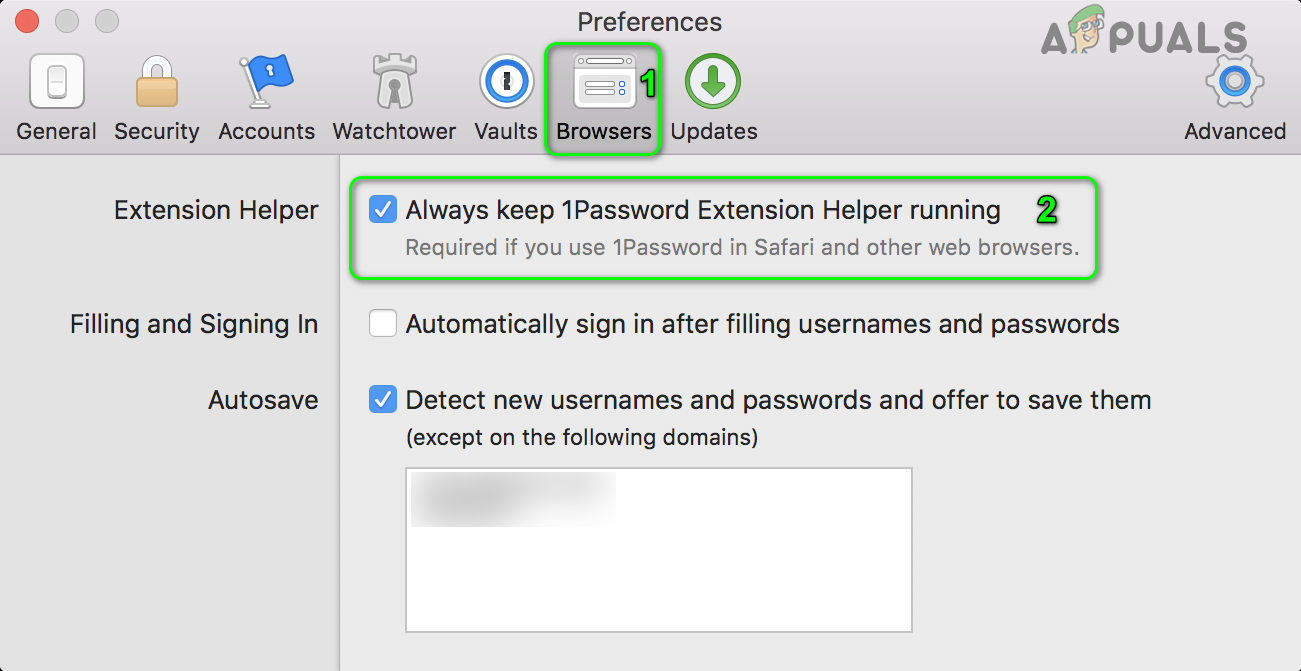
Enable Always Keep 1Password Extension Helper Running - Then check if the 1Password extension is clear of the error.
- If the 1Password Extension Helper option is already enabled at step 2, disable it and restart your system.
- Upon restart, reenable 1Password Extension Helper and check if the issue is resolved.
Solution 6: Re-Run the 1Password Application Setup
The 1Password companion app is essential for the operation of the 1Password extension (non-cloud based). The 1Password may not work if the registry entries regarding the 1Password application are not configured properly. In this context, re-running the 1Password application setup may correct the registry entries and thus solve the problem. For elucidation, we will go through the process for a Windows PC.
- Exit the Chrome browser and 1Password application. Then make sure no Chrome/1Password related process is running in the Task Manager.
- Now launch the Run command box (by pressing Windows + R keys) and then execute the following command:
1Password.exe --setup

Rerun the 1Password Application Setup - Then enter your master password for the 1Password application (if prompted).
- Upon completion of the setup, you will get a prompt that the 1Password application is updated.
- While keeping the 1Password application running, launch the Chrome browser, and check if the 1Password extension works fine.
- If not, then uninstall the 1Password extension as discussed in solution 3 and restart your system.
- Upon restart, repeat steps 1 to 4 and then reinstall the 1Password extension to check if the issue is resolved.
- If the issue persists, download the latest version of the 1Password application.
- Now, exit the Chrome browser and make sure no 1Password related process is running in the Task Manager.
- Then install 1Password application (over existing installation) using the downloaded file (run the file as administrator) at step 8 and then check if the issue is resolved.
Solution 7: Reinstall the 1Password Application
The 1Password companion application can get outdated or its installation files can get corrupt when moving its installation folder. In this scenario, reinstalling the 1Password application may solve the problem. For illustration, we will go through the process of a Windows PC. Mac users can try 1Password Troubleshooting Utility to repair (use all the three repair options, i.e., permissions, extended attributes, and launch services) the installation and if that does not solve the problem, then reinstall the application.
- Backup essential login information and make sure no Chrome/1Password related process is running in the Task Manager.
- Uninstall the 1Password extension, as discussed in solution 3.
- Now, right-click on the Start button and then select Apps & Features.
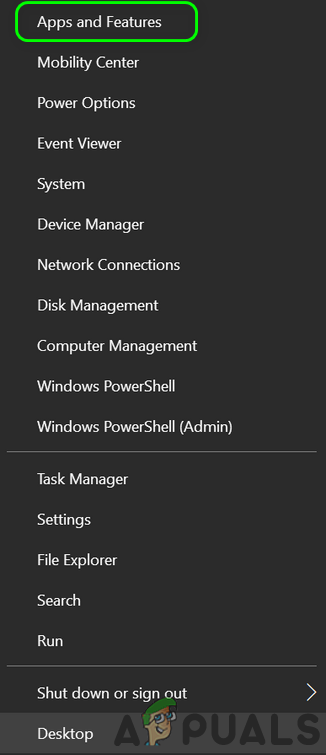
Open Apps & Features - Then expand 1Password and click on the Uninstall button.

Uninstall the 1Password Application - Now confirm to uninstall the 1Password application and then restart your system.
- Upon restart, reinstall the application and extension to check if the issue is resolved.
Solution 8: Disable ‘Verify Web Browser Code Signature’ in the 1Password Application Settings
1Password may refuse to work if you are using an outdated version of 1Password (e.g., 1Password 4) and do not want to update to the latest version of 1Password. In this case, disabling the verification of web browser code signature (in the 1Password application settings) may solve the problem.
Warning: Proceed at your own risk as disabling verification of web browser code signature (which enables the 1Password to distinguish between legitimate Chrome and fake one) may expose your system and data to threats like malware, hacking, etc.
- Launch the 1Password application and open its Help menu.
- Now hoover over Advanced and then uncheck the option of Verify Web Browser Code Signature.
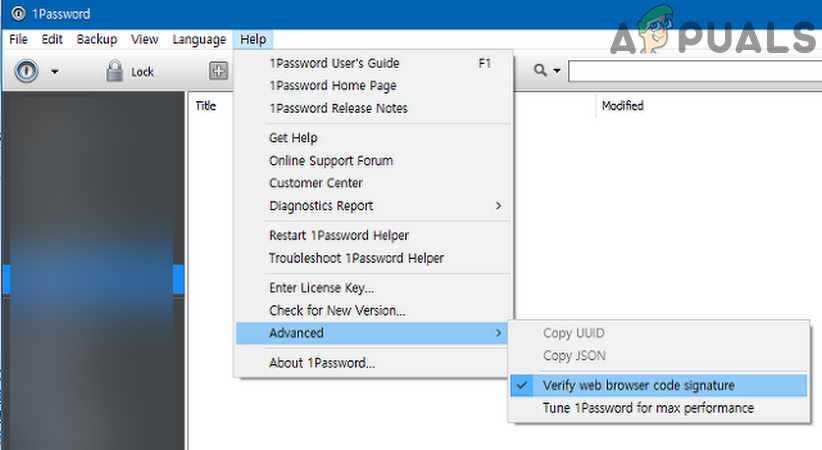
Disable the Option of Verify Web Browser Code Signature - Now, restart your system and upon restart, check if the issue is resolved.
Solution 9: Remove All the Extensions of the Chrome Browser
Chrome’s extensions are used to enhance its functionality, but you may encounter the error under discussion if any of the extensions are interfering in the operation of 1Password. In this scenario, removing all the extensions may solve the problem and help diagnose the culprit.
- Backup essential information/data. Launch the Chrome browser and near the right of the address bar, click on the Extensions icon (the last one in the extensions’ icon).
- Now, remove every extension by clicking on the respective Remove button.

Confirm to Remove the Extension - Then, shut down your computer and wait for one minute.
- Now, power on your computer and launch Chrome.
- Then, add the 1Password extension to Chrome and check if the issue is resolved.
- If not, remove the 1Password extension and power off the computer.
- Then, wait for one minute and power on the system.
- Now, launch the 1Password application and then launch the Chrome browser.
- Then, reinstall the 1Password extension and check if the issue is resolved.
Solution 10: Reinstall the Chrome Browser
If the issue persists (even after trying all the solutions mentioned above), then most probably, the issue may be a result of the corrupt installation of the Chrome browser. In this context, reinstalling the Chrome browser may solve the problem. For elucidation, we will go through the process for a Windows PC.
- Backup the essential information/data in the Chrome browser and its extensions.
- Uninstall the 1Password Chrome extension.
- Exit the Chrome browser and 1Password application. Make sure no 1Password-related process is running in the Task Manager of your system.
- Now, uninstall the 1Password application (as discussed in solution 6).
- Right-click on the Windows button and then click on Apps & Features.
- Now, expand Chrome and then click on the Uninstall button.

Uninstall Chrome in the System Settings - Then select Also Delete Your Browsing Data and click on the Uninstall button.
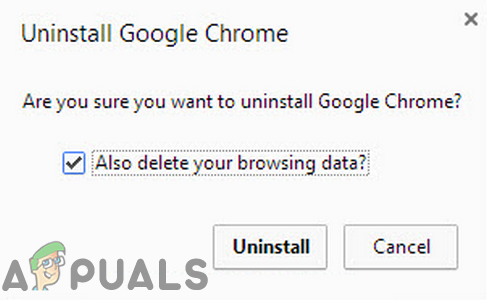
Check the Option of Also Delete Your Browsing Data - Follow the prompts on your screen to uninstall Chrome.
- Now restart your system and, upon restart, launch the File Explorer of your system.
- Then, navigate to the following path:
%localappdata%
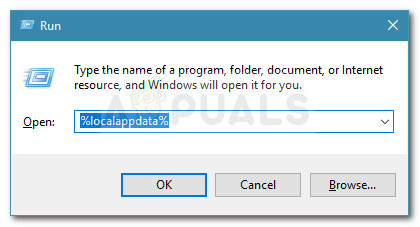
Run dialog box: %localappdata% - Now, in the Local folder, delete the 1Password folder and then delete the Google folder.
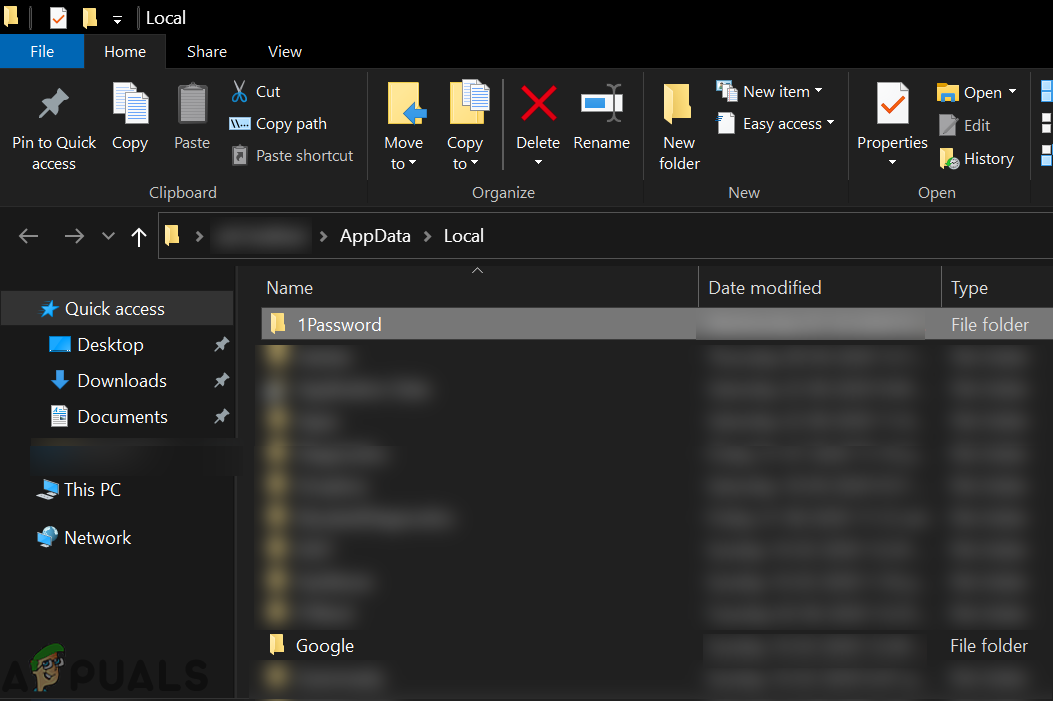
Delete the 1Password and Google Folder - Again, restart your system and then reinstall Chrome and 1Password application.
- Now, reinstall the 1Password extension, and hopefully, the issue is resolved.
If the issue persists, then try to revert to an older version of the 1Password application. On a Mac system, try to move both (Chrome and 1Password application) to the System Applications folder. Also, try to log out of the Mac App Store and iTunes Store, then restart the system. Upon restart, re-login the Mac App Store and iTunes Store to rule out any credentials issue.
Moreover, uncheck the option of Never Display in Browser option in the settings of the 1Password application and check if the problem is resolved. If nothing has worked, try to use the 1Password X extension (after uninstalling 1Password application and extension).





